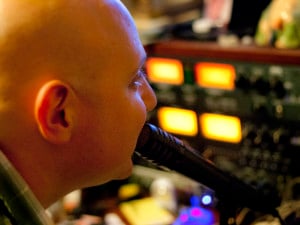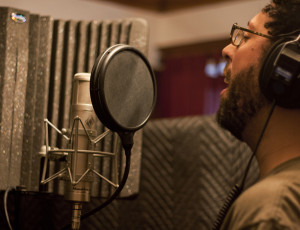PRE-PRODUCTION
What was your pre-production like on this project?
 Josh: We went to a cabin in Southwest Harbor, ME with a couple of acoustic guitars, a banjo, a bass, a keyboard, and a stripped down drum kit. We mapped out and roughly arranged ten songs. We did a simple room-mic demo recording of them. When we started working in the studio, we pulled up the demos and started recreating them as the base for the songs.
Josh: We went to a cabin in Southwest Harbor, ME with a couple of acoustic guitars, a banjo, a bass, a keyboard, and a stripped down drum kit. We mapped out and roughly arranged ten songs. We did a simple room-mic demo recording of them. When we started working in the studio, we pulled up the demos and started recreating them as the base for the songs.
Why did you record at your home studio?
Josh: I have spent the past several years building and improving my personal studio (Black Hat Music in Medford, MA). Over that time it went from a simple place for me to work on my own projects to a viable recording and production studio. I have been fortunate to record and produce some amazing artists over the past couple of years, learning how to best utilize my space and gear along the way. Deciding to record the album at my studio also had a lot to do with knowing the tools, rather than relying on a third party studio for instruments and mics.
We have many different guitars, basses, amps, keyboards and percussion instruments [here] to choose from, and a few different mics and preamps to capture them. We felt confident that we could undertake this project ourselves and would end up with an album that we felt represented us.
PRODUCTION
What kind of sound were you looking for and how did you achieve it?
Shawn: We tend to think about the sound of each song individually rather than the sound of the album as a whole. Our goal is to make an album where no two songs sound alike, yet they still flow as a collection of songs without feeling disjointed. Instead of tracking basics for ten songs at once, we decided to break them into smaller groups (four, four, and three). Since the songs vary in style and feel so much, we thought it would be easier to stay focused if we were only thinking about three or four songs at a time.
 How does it compare to your last release in terms of style and the creative process?
How does it compare to your last release in terms of style and the creative process?
Shawn: I almost feel like making our last EP was our warm-up for making this album. It was our first venture into collaboration and was more about arranging together than writing together. This time around was a lot closer to starting from scratch. We started out just writing chord progressions and mapped out the songs before they even had melodies or lyrics. We’re doing all of the arrangement in the studio this time, whereas last time around we had played a few of the songs live before we started recording them.
Did you use any special miking techniques?
Josh: Drums were recorded using a seven mic setup. There was a Shure Beta52 inside the kick drum, aiming at the lower right quarter of the beater head, Shure SM57s close miking the snare and rack, an Audix i5 on the floor tom, two Oktava MK-012s in an X/Y configuration about four feet over the top of the kick drum, and a Cascade Fat Head about three feet in front of the kit, angled toward the void between the kick and snare.
Almost all of the acoustic guitars were recorded using an Oktava MK-012, positioned where the neck meets the guitar, angled in towards the body, through a Seventh Circle N72 preamp.
While there are many different guitars and amps used on the album, the recorded tone for all of them is a blend between a Cascade Fat Head through the Seventh Circle and a CAD E100 through an ART MPA II. They were positioned with their head baskets touching, roughly three to four feet in front of the amps.
Vocals were all recorded using an Advanced Audio CM12se through the Seventh Circle preamp.
What was your philosophy on live, full-band takes versus individual tracking?
 Josh: Since we’re arranging as we’re recording, all of the tracking has been done individually. Drums were recorded while bass was playing along, but the bass was re-recorded later. Everything else has been layered on.
Josh: Since we’re arranging as we’re recording, all of the tracking has been done individually. Drums were recorded while bass was playing along, but the bass was re-recorded later. Everything else has been layered on.
Shawn: Using the studio as a writing tool is a defining characteristic of the way we work, though some day I would love to try making an album with everyone in a room playing together – maybe that’ll be our next one!
Any special guests?
Shawn: So far we’ve had some backing vocals contributed by members of Parks (Matthew Girard, Brian E. King, Liz McBride), Saraswathi Jones (Tanya Palit), and The Grownup Noise (Paul Hansen, Adam Sankowski).
What did you try to accomplish in the studio that you’re not able to do live?
Josh: While things in the studio inevitably get more complex, we have been conscious of the live show while arranging and recording. We’re trying to not let it get layered to the point that we will be unable to recreate it live.
What were the toughest challenges you faced?
Josh: Engineering and producing an album yourself is always a challenge. There’s a lot of factors at play and the mental switch from creative to technical (or vice versa) can take you out of the moment.
Shawn: We recorded and mixed our previous EP very quickly…at times it has been tough adjusting to a slower pace.
Can you tell us about working with other Boston bands on background vocals?
Shawn: We invited some of our friends who are in Boston bands to come over and sing backing vocals on one of the songs. I hadn’t yet finished writing all of the lyrics so we hadn’t tracked the lead vocals yet. Backing vocals were just “oh oh oh”s so we figured we could just get them out of the way. We sent a demo of the song around with just the backing vocal part so our guest singers could learn the melody. The next day we got this email back from Paul Hansen (lead singer/guitarist, The Grownup Noise):
“Hey guys, so listening to the track today, I kinda wrote a melody and lyrics for it, since I was def feeling it. Which obviously you can punt on, but yeah, just got a little too into it. It felt really good to do either way, and I won’t be offended if you’re already set on lyrics/melody. We can def rock whatever backgrounds you need.”
How could we say no to that? We were dying with curiosity to hear what he came up with and how it stacked up against my lyrics/melody. Paul’s version of the song ended up being so cool we actually used his melody for the chorus, though with my own lyrics, making it our first “accidentally co-written” song. We’ve even been talking about The Grownup Noise recording Paul’s version of the song and releasing both of our versions as a split single.
How will you handle final mixing and mastering?
Shawn: We’ve kind of been mixing each song as we work on it, so we plan on doing the final mixing ourselves. As far as mastering, we plan on working with either TW Walsh (who mastered our last EP) or Steve Mazur (who has mastered several projects that Josh has produced for other artists).
What are your release plans?
Shawn: Our fans who contributed to the PledgeMusic campaign will be the first to hear the album via digital download. We also plan to release [it] on CD.
Any special packaging?
Shawn: We offered our fans the opportunity to have their name and even their photo included in the CD liner notes for contributing to the PledgeMusic campaign, so the packaging (as far as inserts, gate-fold, etc.) depends on how many names and photos we have to include. We’d like to keep the packaging as green as possible (recycled paper, soy ink). The environmental non-profit organization Reverb will also be assisting us in offsetting the carbon [footprint] from manufacturing and shipping CDs.
ALBUM INFO & CREDITS
- Band: Golden Bloom
- Album: TBD
- Recording Studio(s) Used: Black Hat Music (Medford, MA)
- Record Label: TBD
- Release Date: TBD
- Co-Produced by: Shawn Fogel
- Mixed & Co-Produced by: Josh Cohen
KEY GEAR
Instruments:
- Gibson ES-335 electric guitar
- Fender “James Burton” Telecaster
- Morgan Monroe M-30 V acoustic guitar
- Eastwood Airline 3P
- Danelectro “Dead-On ’67” Hornet baritone guitar
- Rickenbacker prototype 4000/4001 bass
- Epiphone MB-250 banjo
- Titano Ideal accordion
Amps:
- Gibson Skylark
- Fender Blues Junior
- Vox AC4TV
Drums/Percussion:
- Yamaha Maple Custom Set
- CB glockenspiel
Software/Plug-Ins:
- Logic Pro 9
- iZotope Alloy, Ozone, Vinyl
- Waves Renaissance Bundle, Classic Compressors, GTR, Q10
- Stillwell Audio Vibe EQ, Bombardier Buss Compressor
- Focusrite Liquid Saffire 56
Monitors:
- KRK VXT6 monitors with KRK 10s sub
Microphones:
- Cascade Fat Head
- Advanced Audio CM12se
- Oktava MK-012
- CAD E100
- Shure SM57
- Shure Beta 52
- Audix i5

